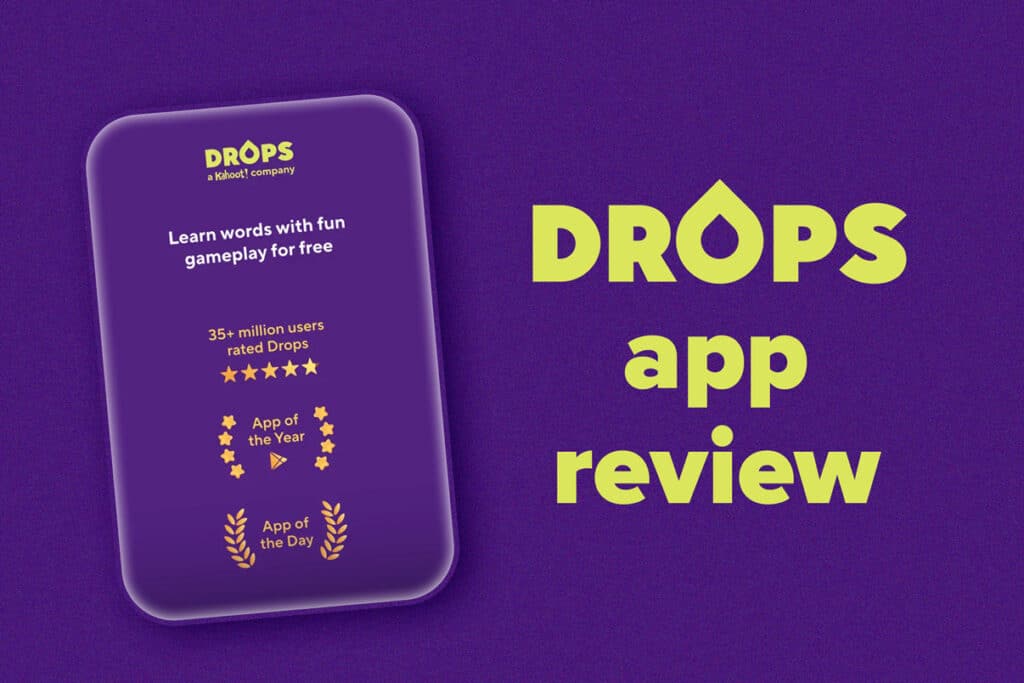
Drops App Review: Worth a Free Download, But Won’t Make You Fluent
Drops is a unique language learning app that prevents you from getting overwhelmed by teaching you a language through gamified lessons limited to five minutes.
But this five-minute limit also makes it extremely hard to learn a language solely through Drops.
While it’s certainly worth the free download if you want fun, bite-sized vocabulary lessons when busy, it’s best paired with a more well-rounded language course.
In this post, I took a deep dive into Drops using its beginner Japanese course to explore the app’s strengths and weaknesses.
Overview

Name: Drops
Description: Bite-sized language lessons to prevent burn-out.
Languages offered: 45 languages, including popular options like German, Chinese and Spanish, as well as more obscure options like Ainu and Igbo.
Offer price: Base program is free; Premium content available with a monthly subscription at $13/month, $69.99/year or $159.99 for lifetime access.
Summary
Drops is a fun and visually appealing app that teaches vocabulary through brief daily sessions. It over-emphasizes brevity, though, and its time-limits may be off-putting for some learners.
- User friendliness - 10/1010/10
- Delivers on promises - 9/109/10
- Authenticity - 7/107/10
- Value for price - 3/103/10
Pros
- Beautiful minimalist interface
- Consistent repetition-based vocabulary learning
- Ability to skip learned words
- Large variety of topics
- Useful language-specific extras, like Japanese kanji writing practice
Cons
- Has a daily five-minute limit for free users
- Only teaches vocabulary
- Minimal audio and no conversation practice
- Paid version doesn’t have much extra content
Contents
Download: This blog post is available as a convenient and portable PDF that you can take anywhere. Click here to get a copy. (Download)
What Is Drops?
Drops is a language learning app that uses five-minute game-like sessions and pictures to teach new words.
Since its creation in 2015, Drops has garnered a pretty positive reputation as an educational resource.
One look at the app’s download count and user ratings can inform you of its esteem and popularity.
Drops has also received positive attention from a number of press outlets, and it even joined the business magazine Fast Company’s 2019 list of 50 “Most Innovative Companies.”
Features
Drops offers lessons for 45 languages.
These include the most popular ones spoken widely, such as German, Chinese and Spanish.
However, more obscure ones—such as Ainu and Igbo—are also available.
The free version gives you daily five-minute learning sessions.
Within each learning session, you learn the lesson vocabulary with micro-games. These games are done in quick succession and vary in format, taking on forms such as mini-crossword puzzles, word construction, text and image match and more.
Some languages may feature other unique learning material.
For example, since I’m learning Japanese, I get access to a “Foundation” section that helps me learn some of the Japanese alphabet and kanji!
How It Works
Once you download the Drops app, you’re immediately asked to pick your target language.
However, this can be changed any time after you start using it.
Through repetition and mnemonics, Drops attempts to make you quickly memorize vocabulary.
Within a given category—which are like Drops’ versions of “lessons”—you’ll encounter words over and over in text, visual and audio format.
During exercises, you can also manually choose which words you feel you don’t have to review, and the app won’t test you on them as frequently.
After your session is over, you’ll have to wait 10 hours for your next round of learning.
Pricing
You can download and continue to use Drops for free.
The free version does have a few expected limitations, though, such as the daily cap of five-minute learning sessions and unavoidable ads.
You also can’t progress to a new vocabulary category until you finish the one you’re currently on.
Drops also has an affordable premium version that’s available on a monthly ($8.49/mo), yearly ($5/mo) or lifetime ($149) subscription.
Drops Premium gives you unlimited playtime, a “Tough Word Dojo” that focuses on more challenging vocabulary, new learner features, additional tests and an ad-free experience.
Overall, the free version can give you much of what the premium has, with just a few inconveniences. But if you want the upgrade, you can get it at a reasonable price.
Drops’ “Sibling” Apps
Drops has “sibling” apps that are also educational but targeted at different users.
Droplets is targeted at kids who are roughly eight to 17 years old.
This app is quite like the main Drops app—down to the five-minute daily limit—but it’s notably easier and more colorful in nature.
The vocabulary topics are also more basic, focusing on the essentials. Think the alphabet, foods, drinks and family.
Scripts is another app that focuses on the written forms of languages.
You learn the alphabet of a language by manually drawing the letters on your screen, training you via muscle memory. Currently, only seven languages are available.
Pros of Drops
There’s plenty to like about Drops, but here are the features that I personally find to be the app’s major stand-outs.
Beautiful Minimalist Interface
Drops’ Fatched with the stark white text and images create a mellow but appealing appearance.
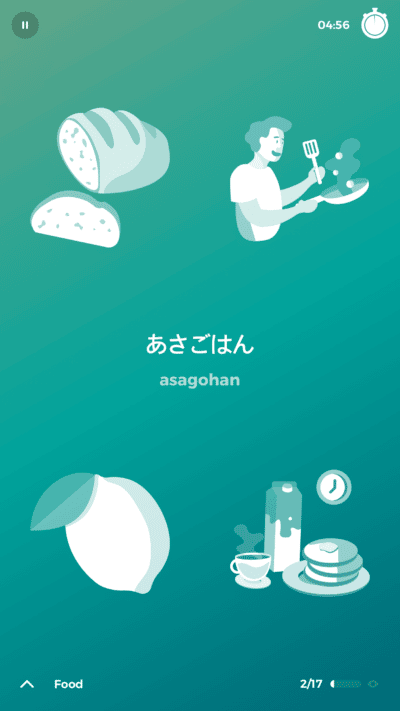
My eyes were at ease as much as they were hooked to the screen.
There are no visual distractions while you’re spending your few daily minutes on the app. Save for the unavoidable ads, Drops doesn’t have other attention-grabbers, like big text bubbles, that fill up the screen.
The minimalism goes beyond just the looks, though.
From the get-go, Drops doesn’t provide many instructions for your exercises, just a quick phrase to get you started.
However, the format makes it easy for anyone to quickly figure out what to do. After you learn how to navigate through exercises, there really isn’t anything else to learn.
I usually find the introductory tutorial sections of learning apps a bit unnecessary, so I was pleased to see that Drops was simple enough that only the bare minimum of instructions were provided.
Consistent Repetition-based Learning
Learning vocabulary by repetition seems like a simple enough concept, but it can be difficult to pull off.
It’s usually not enough to stare at the same word over and over—the timing and format of every encounter matters for proper memorization.
Drops tests you on the same set of words within a given session at different intervals.
But don’t worry, the words are spaced out well enough so that they don’t seem so repetitive and clumpy. I never felt that I saw one word too often or too soon.
There’s also a special “Review Dojo” that’s accessible once you learn 50 words.
The exercises within the Dojo are the same micro-games you would play dozens of times in the free version.
However, the Dojo implements a robust spaced repetition system to amp up your training with the words you need to practice most.
Plus, the Dojo feature also keeps an eye on your successes.
After you consistently get things right, Drops will eventually note that there aren’t any words for you to practice.
Ability to Skip Learned Words
Certain vocabulary will inevitably make its nest in your brain much faster than others.
And while it’s smart to review them occasionally, sometimes you’d rather shift the focus to the words you actually need help memorizing.
In its trademark minimalist manner, Drops provides this option to you directly within the exercises.
This is done by dragging a word to either the top of the screen (to “discard” it) or to the bottom of the screen (to keep it in your session).
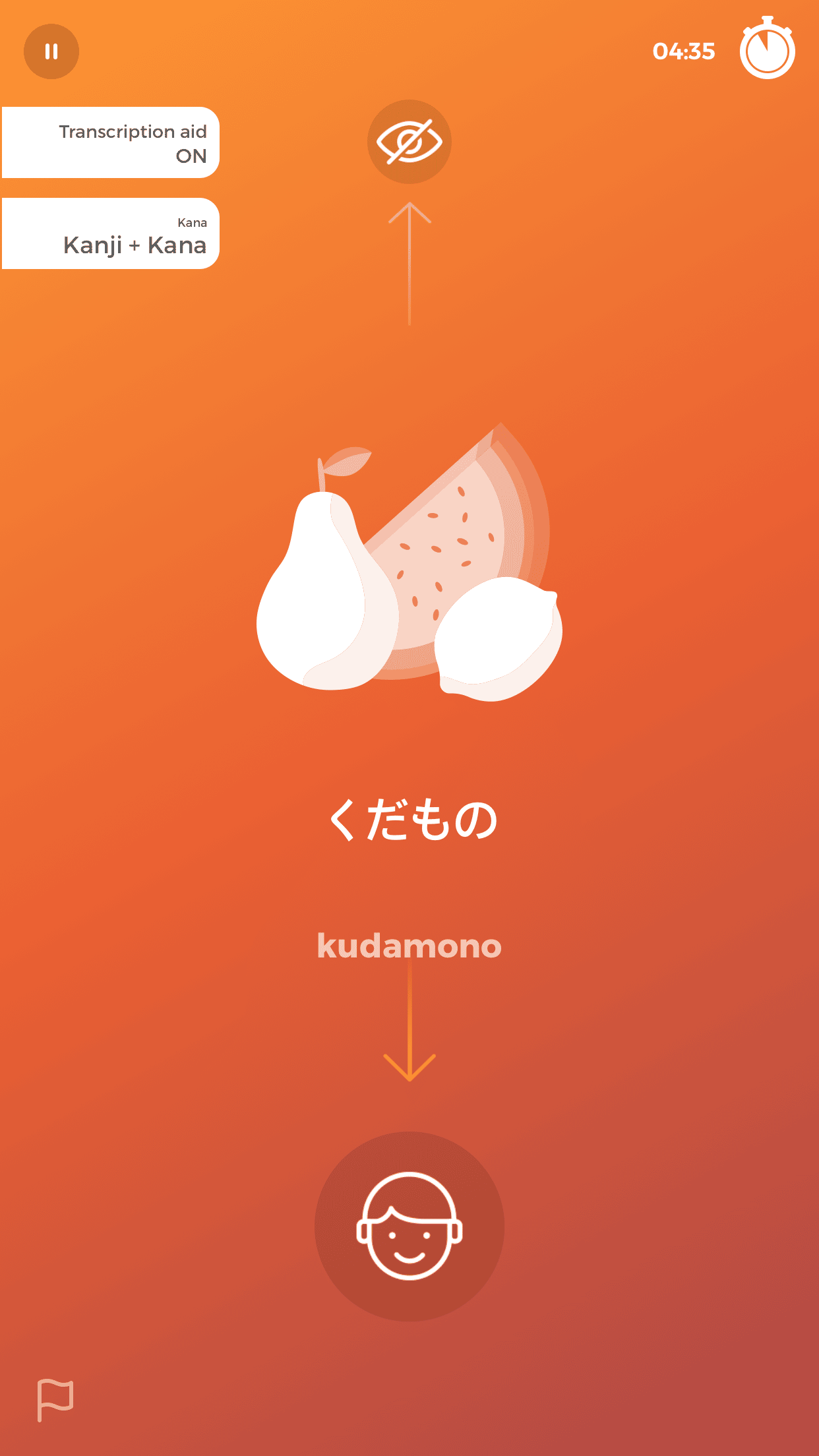
I’ve used this feature a number of times during my trial run and it ended up working quite well.
As soon as I discarded a word I had confidently memorized, it didn’t show up again, letting me work on the vocabulary I was actually keen to practice.
Large Variety of Topics
Drops’ huge vocabulary bank is spread throughout a slew of topics. These include the basics of daily life, such as food, travel, greetings and business.
However, there are also categories—such as gardening, cosmetics and even prison—that perhaps aren’t ones you’d commonly see in other language learning apps.
That means there’s a lot of color and diversity to the words you learn with Drops. The upcoming categories can also be motivational factors that fuel your daily studies.
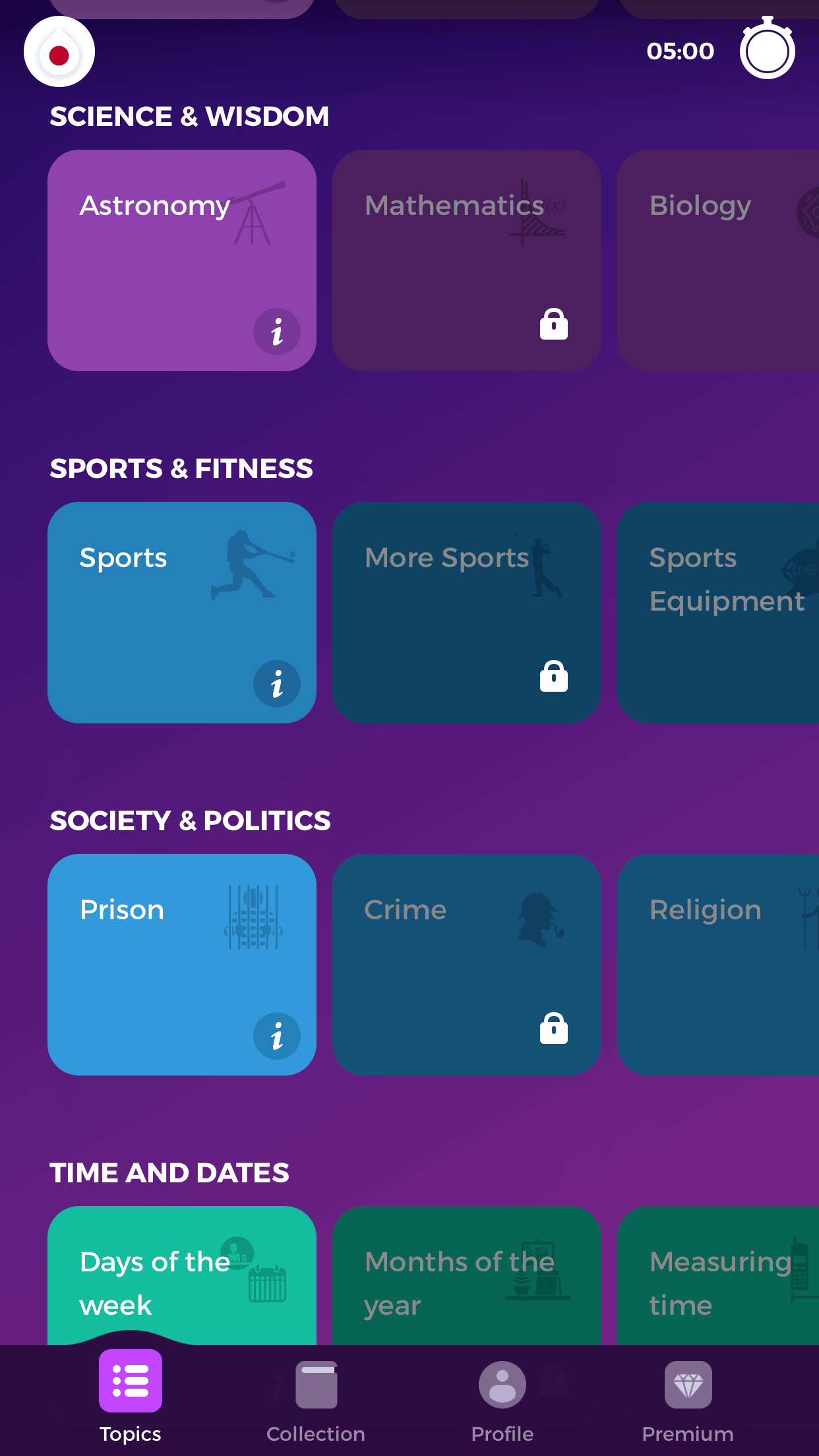
With the free version of Drops, you can access upcoming vocabulary lists only after completing your current ones. The premium version would let you jump to different topics.
Personally, I enjoy having an established learning order because it gives a semblance of structure and curriculum, so it feels a bit like how a language course would be run.
I tend to get overwhelmed when I’m allowed to skip about anywhere I want.
Other learners who are in a rush or only interested in certain vocabulary may find the premium version more beneficial to their needs.
Appreciable Learner Accommodations
As I’m learning Japanese with Drops, I’m privy to a few extra accommodations that I think learners, especially beginners, would appreciate.
Drops’ “beginner Japanese” level primarily focuses on the hiragana alphabet, the most basic of Japanese scripts. However, I also have the ability to learn the other two written systems of katakana and kanji.
For both, Drops lets you actually practice writing out characters by drawing on the screen!
It does so with numbered guides based on the appropriate stroke count. There are also supplemental exercises to help you memorize a character’s pronunciation and/or meaning.
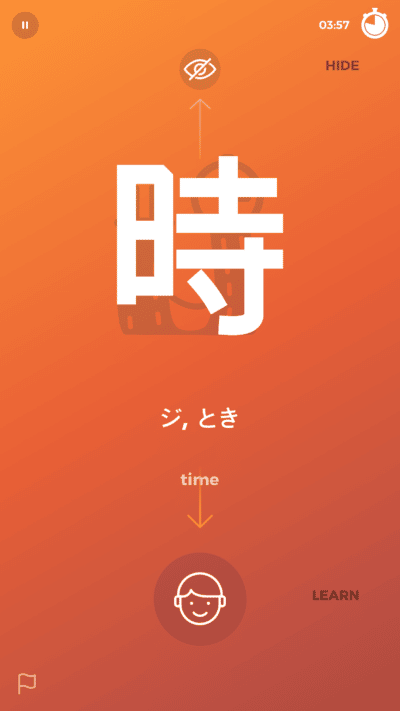
Like standard word learning sessions, you’re also limited to five minutes for character learning sessions.
The same rules apply as well: if you don’t want to practice a word you already know, you can swipe it up the screen and move on to the next one.
Plus, I also got the option to turn on romaji transliterations of all the Japanese words.
This can be great for learning proper pronunciation. Alternatively, I can turn off romaji to work on my reading skills.
It’s a win-win, either way!
Cons of Drops
Clearly, Drops does plenty of things very well. However, it does possess a few notable setbacks that should be discussed.
The Daily Five-minute Limit Is…Limited
The five-minute limit is marketed as a benefit.
Five minutes fits snugly in the pockets of freedom afforded by busy learners. It also works great for language hobbyists or travelers—those who didn’t plan to invest a lot of time into language studies.
However, for avid learners, five minutes may not be enough.
Having used Drops for a number of days under this limit, I did learn a number of Japanese words. But the sessions were like a vocabulary “bum-rush” that ended far too quickly.
I always ended up feeling a bit unfulfilled and craving at least another five minutes of practice.
It felt a bit hollow after my minutes were up, as I was left knowing that I’d have to wait nearly an entire day for my next round.
I’m sure many other learners—who work best with longer stretches of study—may feel the same.
Of course, one could pay for the premium version to get unlimited playtime. But hold fast, since I’ll be addressing my thoughts about Drops Premium later on.
Only Focuses on Vocabulary
If you’re a learner who simply wants to learn words in isolation or to review your vocabulary, then Drops can be a perfect match.
However, language learners who are looking for a comprehensive education will likely find the app lacking.
You won’t get grammar lessons, tips on how to craft functional sentences or how to perfect your accent.
You also won’t get context for the words you do learn, making the learning you get with Drops rather “dictionary-like.”
I can appreciate the fact that Drops isn’t overwhelming by any means, but the singular focus on words (and words alone) can definitely make Drops’ lessons seem curt and vacant at times.
If there were at least a few essential sentences or phrases to learn—or even little snippets explaining unique usages of certain words—the learning experience could be greatly heightened.
Minimal Audio and No Conversation Practice
Drops only provides vocal pronunciations for the words you learn.
This ultimately means that you can’t practice actual conversation in your targeted language.
You can certainly learn how to pronounce individual words, but you won’t learn how to actually “speak.” In fact, there weren’t even that many verbs included in the vocabulary I learned.
This is a huge detriment that potential users should quickly be aware of.
I can imagine that users who depend solely on Drops for language learning may be able to point to and name individual items, but remain wholly unprepared for any extended chat with native speakers.
This problem may be fixed with the addition of narrated example sentences that show the word in use.
That way, learners can actually see a language in action and put the individual slivers they’ve memorized into something comprehensible and usable in real-life scenarios.
Paid Version Doesn’t Have Much Extra Content
Drops’ premium subscription does offer a few extra features.
The most important one, in my opinion, is the ability to have longer learning sessions. The second most important would be the ability to skip over to different categories.
However, the paid version doesn’t provide much else that attracts my attention (or wallet).
One of the biggest draws of most apps’ premium versions is the removal of ads.
Drops Premium does offer this, but rather than shooing away ads, I’d much prefer suffering through them if it meant I could get a substantial amount of extra material.
If the premium version were a little cheaper for what it currently provides, then it may be more appealing. Otherwise, I’d hope that there were more substantial bonuses.
These flaws of Drops can, admittedly, be rather large setbacks for studious language learners.
That’s why I believe that Drops may work best as a supplement to a more robust learning resource that can provide what’s lacking.
Alternatives to the Drops App
FluentU
FluentU teaches you a language naturally through immersion. It’s currently available in 10 languages, including Chinese, Spanish, Japanese and Portuguese.
With FluentU, you hear languages in real-world contexts—the way that native speakers actually use them. Just a quick look will give you an idea of the variety of FluentU videos on offer:

FluentU really takes the grunt work out of learning languages, leaving you with nothing but engaging, effective and efficient learning. It’s already hand-picked the best videos for you and organized them by level and topic. All you have to do is choose any video that strikes your fancy to get started!
Each word in the interactive captions comes with a definition, audio, image, example sentences and more.
Access a complete interactive transcript of every video under the Dialogue tab, and easily review words and phrases from the video under Vocab.
You can use FluentU’s unique adaptive quizzes to learn the vocabulary and phrases from the video through fun questions and exercises. Just swipe left or right to see more examples of the word you're studying.

The program even keeps track of what you’re learning and tells you exactly when it’s time for review, giving you a 100% personalized experience.
Start using the FluentU website on your computer or tablet or, better yet, download the FluentU app from the iTunes or Google Play store. Click here to take advantage of our current sale! (Expires at the end of this month.)
Duolingo
Duolingo is similar to Drops because it advertises itself as a way to “gamify” language learning.
There’s also a large selection of languages, and the app teaches you through short increments of translation, mix-match and listening exercises.
Unlike Drops, there’s no limit to how long you can use the app as long as you don’t run out of hearts (which you lose when making mistakes). But the Premium option lets you skip ads and gets rid of the heart limit.
You can read our full Duolingo review here.
LingoDeer
LingoDeer offers 13 languages, including French, Spanish, Russian, Korean, Thai and Vietnamese.
Unlike Drops, LingoDeer places a heavier emphasis on grammar. The curriculum is crafted by professional teachers and is designed to teach grammar in context through immersion-like lessons that include engaging stories and native-speaker audio.
To learn more about LingoDeer, I recommend reading our in-depth review here.
Clozemaster
Like Drops, Clozemaster’s focus is on expanding your vocabulary.
Clozemaster offers you a quick way to learn new, important words that you’ll use daily. It does so by presenting you with sentences where you have to fill in the blank with a new vocabulary word.
This helps you learn the word in context, naturally. Plus, you can choose from tons of decks—including the most common 1,000, 2,000 or even 5,000 words.
Final Thoughts
Over a few days, I truly enjoyed whizzing through the beautifully formatted exercises and learning all sorts of Japanese words. The way the app has been designed makes using it such a pleasant and comfy experience.
However, Drops simply won’t do as a stand-alone language learning resource.
Therefore, Drops works best as a supplemental resource paired with more substantial and comprehensive ones, and is worth downloading for free.



